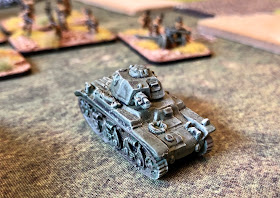That said, there are a few challenges. There are no Osprey books with shiny colour plates, in fact, very little published material at all, even in Turkish. My main source was a handbook written for the British War Office (in the National Archives), probably by a military attache attached to the embassy. I also think he made a few mistakes, which doesn't make matters easier.
There are pictures, although in black and white, and a few items of militaria. We can reasonably assume that the posed public relations photos show the smartest and best equipped troops. There are some pictures of troops on campaign suppressing a rebellion prior to the war, which back up the British handbook's view that rank and file troops were provided with “very shoddy, ill-fitting clothes which in most cases, look extremely shabby, more especially in the east.”
Finding suitable models of Turkish equipment is not that difficult. because there was virtually no indigenous arms industry. They also used a bewildering amount of different weapons, which must have been a supply nightmare.
Models of infantry figures require some conversion. The best equipped troops had a helmet, which looks almost identical to the French Adrian helmet. The rest had a cap, which the nearest equivalent is the Romanian, Chinese or Japanese version. The other distinguishing feature is that almost all the photos show troops wearing gaiters over their leggings. The summer tunic colour is described as khaki coloured canvass, which appears to come in many shades of sand colour according to manufacturer and wear and tear. I suspect many of the helmets were painted the same colour as the uniform, some look even lighter in B&W, but the only one I have actually seen is dark green. If I can find some hard evidence of other colours, I can always repaint.
I decided to start the project at 15mm, not least because you can get away with more than at 28mm. Although I have held back the cap wearing Romanians from the Great Escape Games range to have a go. The closest fit for the helmet wearing infantry I have found so far are the Battlefront Miniatures WW2 French Tirailleurs. They don't have the greatcoat and the five button tunic is a good match. They have leggings, so a bit of work with a file, gives a suitably creased gaiter.
The cap wearing models were a bit more tricky. All the Romanians I could find are helmeted. The Chinese have bandoliers, which leaves the Japanese. Peter Pig do some packs without the sun flap, so I plumped for them. Again some work with the file on the leggings.
The intention was to retain colours on the battlefield for morale purposes. I suspect that wouldn't have lasted long had they joined the conflict. However, I have kept one for a command element. Anti-tank guns were limited, but they used the French 25mm and the German 37mm, which were easily sourced.
In March 1940 they had 100 Russian T26 tanks and 50 French R35s. The T26s come from my SCW army along with a BA6 armoured car, which they also had. Helpfully, they appear to have retained the Russian green.
The army needs some more rifle units and a 75mm field gun. Later in the war they acquired German Pkw III and IVs, plus British Valentine, Shermans, more Vickers and other stuff I have in abundance. Opponents can be German, Russian, British and Bulgarian, depending on the period. Now, Bulgarians, there's an idea!




The Air Force was an interesting mix - Fairey Battles, FW190s and P47s with some other odds and ends - Hurricanes I believe - which would be easily sourced.
ReplyDeleteCertainly an interesting ‘what if?’ Set up.
All the best,
DC
Plus American Vultee, Martin 139, German Heinkel HeIII, French MS 406, Polish PZL P-24...... A quartermasters nightmare! They actually buried 50 of the FW190's after the war. I have seen a story about aircraft enthusiasts digging them up in recent years.https://www.warhistoryonline.com/war-articles/50-luftwaffe-fw-190-fighters-found-buried-in-turkey.html
ReplyDeleteI believe they also bought some deacons in 1943 or so
ReplyDeleteThat's interesting. My secondary source says they bought 48 Bishop SPGs, which served in the artillery regt attached to armoured brigades. But I have some more digging to do in the primary British sources.
ReplyDeleteGreat resource for wargamers like myself looking at the Turkish forces. Started building a force in 6mm. Just wondering what the Turkish armour colour was. Were German supplied PzIII and PzIV the same colour as the Valentines etc.
ReplyDeleteCheers, Richard P
As with all colours in the pre-colour film age, we are not sure. There does not appear to have been any consistency either in uniforms or vehicles, even allowing for wear and tear. Not helped by big gaps in the archives and museum coverage of this period.
DeleteI have gone for Soviet green as that is the colour on the T26 outside the military museum in Istanbul. The British supplied armour later in the war probably came in desert camo as they came from Middle East stocks. However, that wouldn't have been suitable for Thrace where most of the armour was stationed. So, it seem s likely that they would be repainted in a similar green, which is confirmed (sort of) in the very few and poor quality pictures. The German tanks almost certainly came in panzer grey and may have been left in that colour as they were based in Ankara, or repainted like the others. There is a picture of a T26 unit with a wavy camo pattern, possibly a dark sand or light brown over the Green. So if you want some variety to differentiate units, that would be fine. Hope that helps.
That's great! Many thanks.
Delete